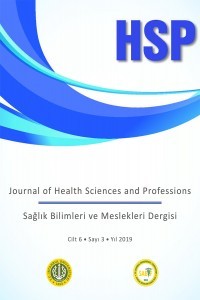Anne Sütü Bağışı: Türkiye’deki Durum
Emzirme, anne sütü; bağışçı (donör) sütü; süt bankaları.
-
Breast milk donor milk, milk banks,
___
- World Health Organization (WHO) and UNICEF. Global strategy for infant and young child feeding. Geneva, Switzerland: 200 Available from: http://whqlibdoc.who.int/publications/2009/9789241597494_eng.pdf
- Mackenzie C, Javanparast, Newman L. Mothers' knowledge of and attitudes toward human milk banking in South Australia: a qualitative study. Journal Of Human Lactation. 2013; 29(2):222-9.
- Gürol A, Özkan A, Çelebioğlu H. Turkish women’s knowledge and views regarding mother’s milk banking. Collegian. 2013; 206; 1-6.
- Chang FY, Cheng SW, Wu TZ, Fang LJ. Characteristics of the first human milk bank in Taiwan. Pediatrics and Neonatology . 2013; 54(1):28-33.
- Hsu HT, Fong TV, Hassan NM, Wong HL, Rai JK, Khalid Z. Human milk donation is an alternative to human milk bank. Breastfeeding Medicine. 2012; 7(2):118-22.
- American Academy of Pediatrics. Policy Statement: Breastfeeding and the use of human milk. Pediatrics. 2012; 129, 827–841.
- Ramli N, Ibrahim NR. , Hans VR. Human milk banks: The benefits and issues in an Islamic setting. Eastern Journal Of Medicine. 2010; 15(4): 163-167.
- Boyd CA, Quigley MA, Brocklehurst P. Donor breast milk versus infant formula for preterm infants: Systematic review and meta-analysis. Arch Dis Child Fetal Neonatal Ed.2007; 92:169-75.
- Quigley M, Henderson G, Anthony M, McGuire W. Formula milk versus donor breast milk for feeding preterm or low birth weight infants. Cochrane Database Syst Rev. 2007 17;(4):1-23.
- McGuire W, Anthony MY. Donor human milk versus formula for preventing necrotizing enterocolitis in preterm infants: Systemic review. Arch Dis Child Fetal Neonatal Ed.2003; 88:11–14.
- Gartner LM, Morton J, Lawrence RA. Breastfeeding and the use of human milk. Pediatrics. 2005; 115: 496-506.
- Lucas A, Morely R, Cole TJ. Randomized trial of early diet in preterm babies and later intelligence quotient. BMJ. 1998; 317(7171): 1481–1487.
- Anderson JW, Johnstone BM, Remley DT. Breast-feeding and cognitive development: a meta-analysis. Am J Clin Nutr. 1999; 70(4): 525-535.
- Davies DP. Adequacy of expressed breast milk for early growth of preterm infants. Arch Dis Child 1977; 52(4):296-301.
- Schultz K, Soltész G, Mestyán J. The metabolic consequences of human milk and formula feeding in premature infants. Acta Paediatr Scand.1980;69(5):647-52.
- Gross SJ. Growth and biochemical response of preterm infants fed human milk or modified infant formula. N Engl J Med. 1983; 3;308(5):237-41.
- Tyson JE, Lasky RE, Mize CE. Growth, metabolic response, and development in verylow- birth-weight infants fed banked human milk or enriched formula. J Pediatr. 1983; 103(1):95-104.
- Lucas A, Gore SM, Cole TJ. Multicentre trial on feeding low birthweight infants: effects of diet on early growth. Arch Dis Child. 1984; ( 59):722-730.
- Schanler RJ, Lau C, Hurst NM, Smith EO. Randomized trial of donor human milk versus preterm formula as substitutes for mothers' own milk in the feeding of extremely premature infants. Pediatrics. 2005;116(2):400-6.
- Tudehope DI. Human milk and the nutritional needs of preterm infants. The Journal of Pediatrics. 2013;162(3):17-25.
- Kim JH, Unger S. Human milk banking. Paediatrics- Child Health. 2010; 15(9): 595– 5
- Wight NE . Donor human milk for preterm infants. J Perinatol. 2001; 21: 249-254. Lucas A, Cole TJ. Breast milk and neonatal necrotising enterocolitis. The Lancet. 1990;336 (22): 1519–1523.
- Gribble KD. Peer-to-peer milk donors' and recipients' experiences and perceptions of donor milk banks. Journal of Obstetric, Gynecologic And Neonatal Nursing . 2013; 42(4):451-61.
- Human Milk Banking Association of North America. Guidelines for the establishment and operation of donor human milk banks. 2011. Fort Worth, TX.
- Rosenbaum K. Implementing the use of donor milk in the hospital setting: implications for nurses. Nursing for Women’s Health. 2012: 16(3): 202-208.
- Kennaugh J., Bormon L. The increasing importance of human milk banks. E-Journal Of Neonatogy Research. 2011; 1(3): 119-125.
- Updegrove K. Nonprofit human milk banking in The United States. Journal Of Midwifery - Women’s Health. 2013; 58, (5), 502–508.
- Avishai O. Managing the lactating body: The breast-feeding project and privileged motherhood. Qualitative Sociology. 2007;30(2),135–152.
- Stearns CA. The work of breastfeeding. Women’s Studies Quarterly. 2009; 37(3/4), 63–
- Shaw R, Bartlett A. Giving breastmilk: Body ethics and contemporary breastfeeding practice. 1 st ed: Bradford,Canada; Demeter Press; 2010. p. 83–97.
- NICE Clinical Guideline. Donor breast milk banks: the operation of donor milk bank services. 2010. Available from: http:// www.nice.org.uk/guidance/CG93.
- Hartmann BT, Pang WW, Keil AD, Hartmann PE,Simmer K. Best practice guidelines for the operation of a donor human milk bank in an Australian NICU . Early Human Development. 2007; 83(10):667- 673.
- Simmer K, Hartmann B. The knows and unknows of human milk banking. Early Human Development.2009: 85 (11):701-704.
- El-Khuffash AL, Unger S. The concept of milk kinship in Islam: Issues raised when offering preterm infants of muslim families donor human milk. Journal Of Human Lactation. 2012; 28(2):125-7.
- ISSN: 2148-7588
- Başlangıç: 2014
- Yayıncı: İstanbul Üniversitesi-Cerrahpaşa
Hemşirelik Öğrencilerinin Bilimsel Araştırmaya Yönelik Kaygı Ve Tutumlarının Belirlenmesi
Anne Sütü Bağışı: Türkiye’deki Durum
Merve KADIOĞLU, Nevin HOTUN ŞAHİN
Hediye BEKMEZCİ, Serap EJDER APAY, Hava ÖZKAN
Çocuklarda Obezitenin Önlenmesi ve Yönetiminde Hemşirenin Rolü
Leyla ERDİM, Ayşe ERGUN, Sema KUĞUOĞLU
Türkiye'de Çocukların Katılım Hakkı Üzerine Bir Derleme
Mustafa YAZICIOĞLU, Doğaç ÖZÜÇELİK, Barış AYVACI, Derya ÖZAŞIR, Yılmaz AYDIN, Uyarış ÇOBAN, Halil DOĞAN
Çocuklarda Cinsel İstismara Bağlı Travma Sonrası Stres Bozukluğu: Olgu Analizi
Gülçin BOZKURT, Coşkun YORULMAZ, Duygu SÖNMEZ DÜZKAYA
Riskli Olan ve Olmayan Gebelerin Psiko-Sosyal Sağlıklarının Karşılaştırılması
Mehtap GÜMÜŞDAŞ, Serap EJDER APAY, Elif ÖZORHAN
Alis KOSTANOĞLU, Ela TARAKCI, Enver DAYIOĞLU, Sabriye DEMİRCİ
Nöromusküler Hastalıklarda Solunum Fonksiyonlarının Değerlendirilmesi: Derleme
